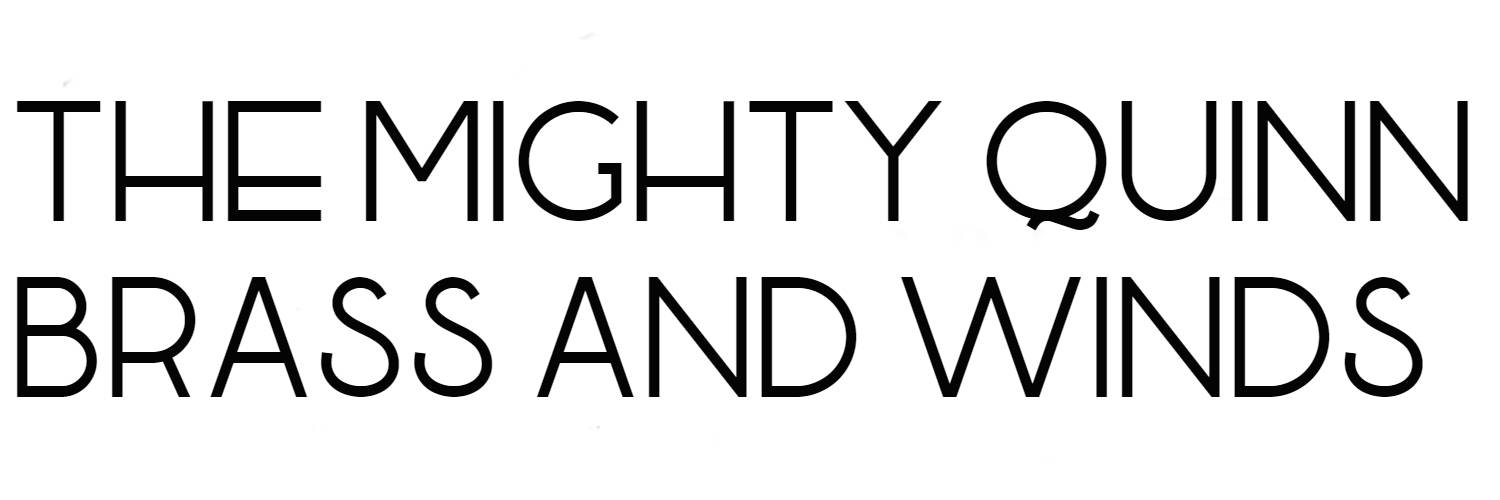Giving Life to the Triebert Brevete “Systeme Dupaquier” C Melody
The Story
Since the beginning of Quinn the Eskimo, certainly well before breaking into the new band instrument market, we have dealt with vintage instruments. On a quest for world domination, “Supreme Commander” Matt Stoecker has scoured the country in whatever form he could, trying to unearth the most intriguing band instruments in the world, or simply those that had died long ago, but had the potential to be something more after being passed on to either myself, or our senior tech, Brad Wherry. As such, many of the instruments we get into our shop are not what might be considered “player’s horns”.
Along with our inventory of fine vintage instruments, what we see a huge amount of are the horns that have been sitting in an attic for 20 years; the horns that have been dropped down staircases, or crushed in shipping; the horns that are missing parts which can no longer be found and thus have to be manufactured from raw brass. Over the past few years that I’ve been working with Matt, his business model has presented a host of situations that would be simultaneously rewarding and infuriating to any tech, but occasionally it grants me the opportunity to see something truly unique.
A number of months ago, our shop received a call from one of our suppliers saying that they had recently unearthed a selection of unique and as-of-yet unidentified saxophones from their warehouse. The instruments in question had been sitting in storage for however long, and before they tossed them, they had thought it wise to offer them to Matt, knowing his aforementioned taste for unique finds. They settled on a price and soon enough, a small delivery of dusty saxophones arrived at our headquarters. Without any accompanying paperwork, we inspected the horns one by one in an eager attempt to trace the lineage of each one. We eventually managed to identify a couple suspected prototypes to some historically significant horns, as well as a very unusual slide saxophone.
This was not, however, the end of our haul: accompanying the rest of the instruments, was a heavily aged Triebert Brevete tenor with an intriguing stamp on the bell reading “Systeme Dupaquier.” Like the other saxophones in the lot, it had been collecting dust in a warehouse with no indication of where it had come from or how long it had existed. Matt was the first to examine it, and after studying it intently for some time, quizzically called Brad and myself over to show us what had found its way into the shop. On closer inspection, what appeared to be a normal tenor turned out to be a C-melody, deceptively made larger by the addition of three bell keys which extended the range down to Low G, as well as an added high F# and high G. In other words, this particular saxophone had been engineered to have an extended range of three complete octaves.
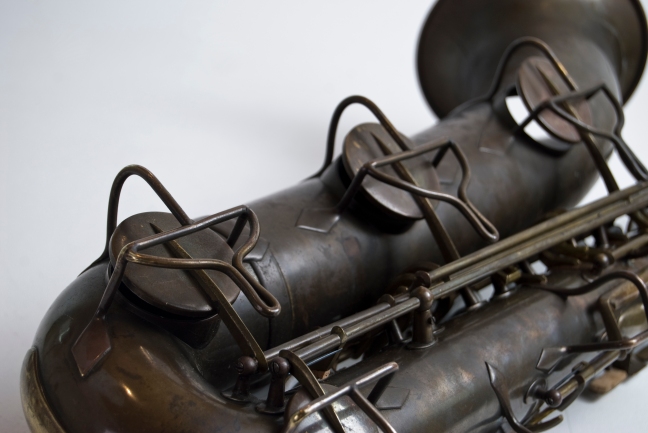
It isn’t uncommon to see extended range saxophones: most modern Baritones, for example, are ranged down to low A, and high F# is a common addition to saxophones of any range, but a saxophone that is ranged not only up, but down to G is virtually unheard of. In fact, in the years that Matt, Brad, and myself have collectively been working in this industry, none of us had seen a saxophone even remotely similar to this one. Even researching the saxophone online contained very few notable results. From what I was able to gather, the earliest mention of this type of instrument can be found in a 1912 catalog, which states that it was the result of a meeting between Couesnon and a member of the French Republican Guard, a “Mr. Dupaquier”, who had contacted them requesting a saxophone that could be used as a replacement for various other orchestral instruments, most notably the cello, but that was familiar enough that it could be easily played by any previously trained saxophonist. Unfortunately, as with many of the esoteric designs that appeared during the formative years of the instrument, the design simply didn’t catch on and as a result, it faded into obscurity.
The Process
After some brief discussion, it was decided that I was to repad the instrument. As I started the process, to my delight, despite the thick surface dirt and badly oxidized screws, the horn gave almost no issues in disassembling, with the exception of a roller screw which had been slightly rusted. Almost equally as surprising given the condition in which it was allegedly kept, the instrument only needed minor dent work.
It was here during the initial disassembling/cleaning, that I was able to see just how bizarre this saxophone is. Every make/model of saxophone will be slightly different from the next, but more or less, they will follow the same “guidelines”, with minor adjustments made to the formula to fit the specific instrument. In order to illustrate this, lets look at the low Eb, and C keys: Eb is normally closed, and is the last key on the main section of the body tube, whereas Low C is open and extends down at an angle so that the key cup reaches down to the bottom bow of the saxophone. On any modern saxophone, these are typically played by pressing the pinky finger down on one of the two table keys just below the right hand stack. In the case of the Triebert, however, in order to accommodate the extended range, a total of 21 keys had to either be drastically modified, or custom made specifically for this instrument. Going back to the Eb/C keys, the Eb of the Triebert is more or less played as you would expect, and carries a familiar design. However, Low C is not only moved up onto the body tube – and is in fact the last key on the right hand stack – but it can be triggered by five completely separate key inputs, and can be played normally as Low C in three different ways.
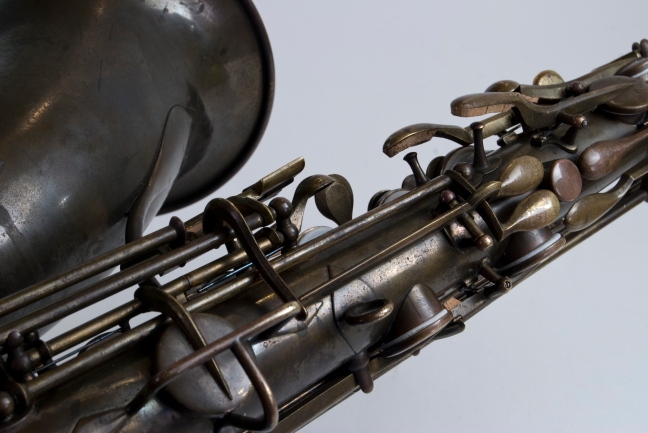
Something that came to be both a blessing and a curse was the highly malleable metal used to fashion not only the body, but the keys, and screws as well. Dent work went without any sort of struggle, as the body easily contorted back into shape; however, the same brass that had made dent work so refreshingly easy contributed to a host of problems. One of the design elements that, while not a problem in it’s own right, compounded with the soft brass, was that the Triebert was built with soldered tone holes. This was actually a relatively common practice in vintage saxophones, but it is common – especially for older, well-traveled instruments – for cracks to developed in the solder which can not only be difficult to spot, but can be devastating to tone if not fixed, as they are akin to leaking pads. Because the body of the saxophone is vastly more flexible than most (if not any) other saxophone I can recall working on, the tone hole solder joints were inherently more susceptible to forming cracks than other saxophones that use this method of creating tone holes, and as such, many of the joints needed to be patched with soft solder.
Thus I became aware of one of the biggest design pitfalls of the Triebert: the metal was so flexible, that the slightest knock (even setting it down on my work bench too carelessly) would bend a key out of alignment; in some cases, applying slightly too much pressure on a key while play testing would bend the key to such an extent that it affected the action; at one point, in an attempt to test just how fragile the brass actually was, I was not only able to dent the bell of the saxophone but also effectively remove the same dent, using only my thumb. Owing to the flexibility of the brass, many of the posts had been knocked out of position (presumably during the cleaning process when all of the keys had been taken off of the body). As with the soldered tone holes, this is something that is actually common, easy to fix, and usually does not affect the motion of the keys outside of affecting how they land on their respective tone holes. However, the unique characteristics of the materials led to an interesting scenario in which, even though the posts neither appeared to be visually misaligned, nor did the keys feel physically loose on their respective posts when assembled, the keys actually bound on their rod screws unless every single post was reset to it’s intended position since even the slightest misalignment would warp the assigned rod screw.
Eventually the process was completed and overall, it was a fascinating experience. Fully assembled and adjusted, keys finally moving freely in my hands, the old beast was able to show itself for what it was: physically heavy, yet surprisingly ergonomic, and once played, shockingly in tune for the kind of instrument that it is. Admittedly, I can be a sentimental person and it’s easy for me to develop attachments to certain instruments: the first instrument I ever worked on, for example, was a silver saxello, which I was tasked with disassembling and polishing in preparation for a repad; the first key I ever made was the upper brace that connects the neck receiver of a MKVI baritone to the body tube; I can remember that the first time I ever worked on a sarrusophone, it was a windy night at the end of June 2015, in which I was worried I would lose power and miss my deadline. Typically, these memories can be assigned to milestones in my career, but I can rest assured knowing that I will polish more saxellos, make more keys, and see more sarrusophones before the end and unfortunately, I can’t confidently say the same about the Triebert Systeme Dupaquier C melody.
The Design
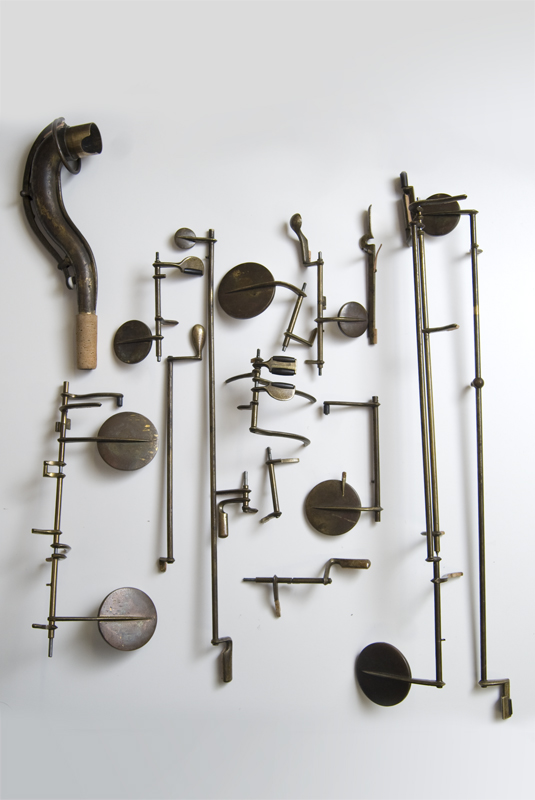
As previously stated, the Triebert contains a total of 21 new keys: the following is an annotated photo diary of the unique key mechanisms present in this instrument, starting with High G, and traveling down the instrument to Low G. Click to enlarge.
HIGH F#-G
the High F# and G keys are easily accessible with the index finger of the right hand. In order to accommodate the extended range without affecting the tuning of the instrument, the High G tone hole has been built into the neck receiver, with a notch cut into the neck tenon itself to allow for ventilation of the tone hole.
G#
The inclusion of a dual-vented G key necessitated moving the G# key to the back of the instrument. The G# lever and the G# key are on the same rod screw, but are separated, and interact with each other by way of a tab located on the bottom of each key; this is so that when F# is closed on the right hand stack, the G# lever can still move independently of the G# key itself – without affecting F# – regardless of being on the same screw.
LOW C
There are a number of different methods of activating Low C, and it’s quite possibly the most complicated mechanism on the horn. The first of which is a method that is unique to this instrument whereby pressing the bottom of the two right-hand thumb keys will activate the key. However, this is not the intended main point of activation: the right thumb key is split in two and connected with a tab, in the same way that G# is split in two, and activating the thumb key does not directly hold Low C down, but instead allows the second half of the thumb lever key to hold Low C down using only its own spring tension. The purpose of this is to keep Low C closed but physically free, and instead transforms it into a sort of trill key whereby pressing the table key to Low Eb will open not only Low Eb, but also Low C, allowing for extremely quick transitions between Eb/C without the need to move the pinky finger between two different table keys.
The next method is the traditional method of using the right pinky to activate its corresponding table key; however, on the C melody, this means pressing down the middle of the three table keys available.
B, Bb, C
The first pair of the five bell keys are B, and Bb, and are operated in the same way as on a normal saxophone, using the left pinky on the corresponding table keys. There is a secondary method of activation by way of a left-hand thumb key, located beneath the octave levers.
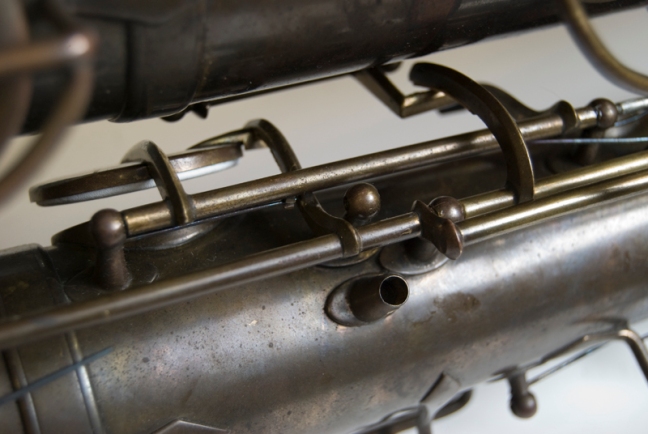
In addition to activating B and Bb, any method of activating these first two bell keys also activates Low C, via an arm which extends off B, travels under the right hand stack, and connects to a tab on the side of the low C key cup.
Bb, A
The next pair of bell keys moving down the bell, are Bb and A, which are activated using the lowest of the three right-hand pinky table keys.
A, G#
Following Bb and A are the A and G# keys, which are activated via the upper-most of the two right-hand thumb keys
G#, G
Finally, the lowest of the bell keys is the pairing of G# and G, which are activated through the furthest right of the two left-hand thumb keys, located below the octave levers.
Image Gallery









